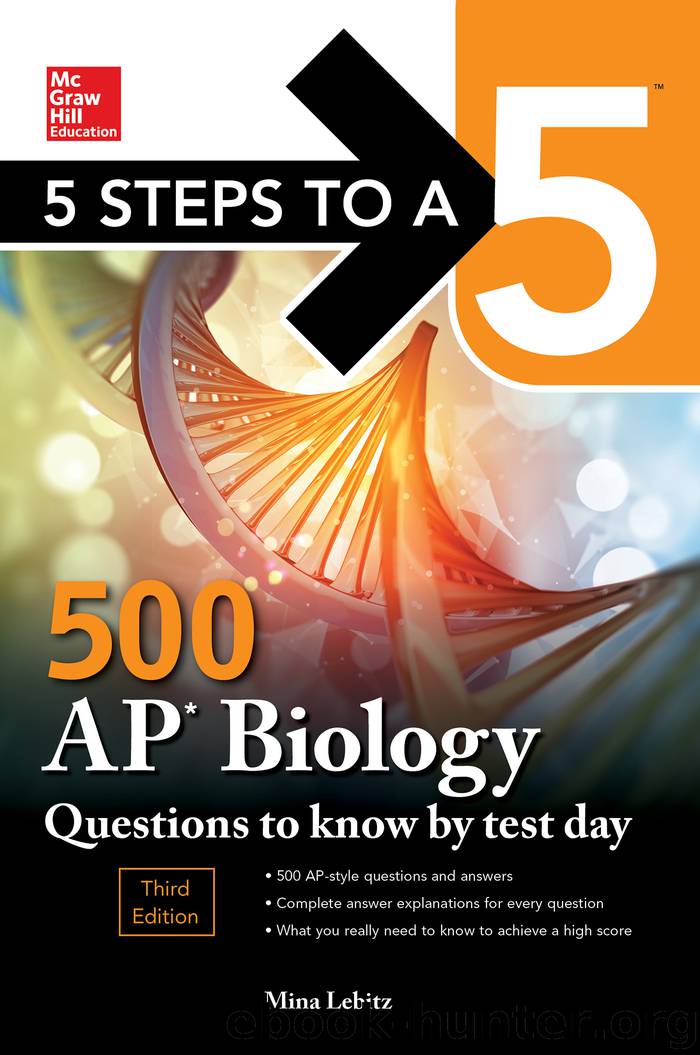5 Steps to a 5 500 AP Biology Questions to Know by Test Day by Mina Lebitz

Author:Mina Lebitz
Language: eng
Format: epub
Publisher: McGraw-Hill Education
Published: 2019-07-25T16:00:00+00:00
Choices A, B, and D all illustrate that smaller populations tend to have less variation and a lower frequency of heterozygotes. Larger populations tend to exhibit greater diversity than small populations, as well. In fact, average heterozygosity is used by scientists as a proxy for genetic diversity.
Choice C is the least illustrative of the data because with frequency-dependent selection, the fitness of a particular genotype varies as a function of its frequency. but whether the genotype is homozygous or heterozygous is irrelevant to the concept of heterozygosity and diversity being tested.
62. (C) Dark moths are not necessarily preferred by birds, since in the polluted woods the light moths are eaten more. The populations of each color are not known, so choice B is not necessarily true. It may be that dark moths are so common that they get eaten more just from higher frequency (though not likely). The most probable explanation of the data is that the dark moths are well camouflaged in the polluted woods and the light moths are better camouflaged in the unpolluted woods.
The coloring of the moths matters because the birds use the sense of vision to find the moths. It’s easy to imagine this since humans are very visual animals, but it’s important to remember that vision is not necessarily important to every animal species, even predators. However, vision is the most important sense for birds, particularly because it is essential for safe flight (though bats use sonar). Birds of prey tend to have the greatest visual acuity. Interestingly, birds have four types of color receptors (as opposed to three, as in humans). The extra “color” receptor confers vision in the UV range of the electromagnetic spectrum.
63. (C) The data are a “snapshot” of the current situation. There is no time variable included. The percentage of light moths eaten by birds was higher in the polluted woods versus the unpolluted woods. The total number of moths eaten is lower in the polluted woods, as well. However, with no other information about the diet of the birds, the effect on their biomass cannot be determined.
In the polluted woods, light moths are eaten more than dark ones, which could decrease the population over time. The dark moths are eaten more than the light moths in the unpolluted forest, so the ratio of light to dark is expected to increase over time, regardless of the starting population size. Because only a few trees were samples, it is not possible to tell if the polluted woods will have a lower number of dark moths, especially since the dark moths are less likely to be eaten by birds in the polluted woods.
64. There are many pieces of biochemical and genetic evidence supporting the hypothesis that all organisms on Earth share a common origin of life. The following is an (incomplete) list:
• All organisms use the same genetic code to assemble polypeptides from DNA nucleotide sequences.
• All organisms use the same enantiomer of amino acids (L-) and sugars (D-).
• Gene sequence
Download
This site does not store any files on its server. We only index and link to content provided by other sites. Please contact the content providers to delete copyright contents if any and email us, we'll remove relevant links or contents immediately.
| ASVAB | GED |
| GRE | NCLEX |
| PRAXIS | SAT |
| See more | Flash Cards |
| Study Guides | Study Skills |
| Workbooks |
Talking to Strangers by Malcolm Gladwell(13222)
The Compound Effect by Darren Hardy(8808)
Tools of Titans by Timothy Ferriss(8218)
Wonder by R. J. Palacio(8009)
The Lover by Duras Marguerite(7830)
A Court of Wings and Ruin by Sarah J. Maas(7651)
The Circle by Dave Eggers(7035)
Deep Work by Cal Newport(6879)
Kaplan MCAT General Chemistry Review by Kaplan(6866)
To All the Boys I've Loved Before by Jenny Han(5775)
Wiseguy by Nicholas Pileggi(5671)
The Body: A Guide for Occupants by Bill Bryson(4974)
1,001 ASVAB Practice Questions For Dummies by Powers Rod(4453)
Eat That Frog! by Brian Tracy(4434)
Cracking the GRE Premium Edition with 6 Practice Tests, 2015 (Graduate School Test Preparation) by Princeton Review(4224)
Pre-Suasion: A Revolutionary Way to Influence and Persuade by Robert Cialdini(4145)
Barron's AP Biology by Goldberg M.S. Deborah T(4097)
ACT Math For Dummies by Zegarelli Mark(3994)
Alive: The Story of the Andes Survivors by Piers Paul Read(3968)
